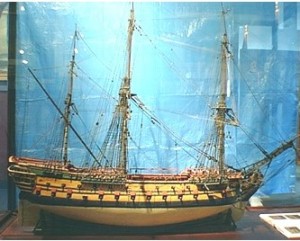HMS MARS, 74-GUN
The Ship
Built in 1794, HMS MARS was 
launched at Deptford, a
borough of London, England.
She was Admiral Hood’s
flagship at the battle of
Trafalgar, second in line behind
Lord Nelson in HMS Victory.
There are conflicting records
that she was broken up or
burned and sank in 1823.
The Model
The model is catalogued as a royal dockyard Admiralty model, probably built in 1793. The model is constructed of pear, oak and pine with a gilded figurehead and mounted on a slipway.
The model is now the center of some academic controversy. The conventional wisdom about Admiralty models has been that at that time in history, few, if any ships were designed on paper before they were built. The dockyards had developed the practice of building a ship model to conform to requirements of the Admiralty. When the model was approved, it was returned to the dockyard and the ship was built from the measurements of the model. Lately, there has been considerable controversy over whether these models were ever used as a design tool or whether they were built as a sort of archive taken from the measurements of the actual ship or possibly as a commemorative gift to the builder or the sponsor. In any event, these Admiralty models are highly prized collectors’ items in Europe and we are fortunate to have this one.
However, there is an entirely different way to look at this model. At the end of the Anglo-Dutch wars in 1674, the interests of the Dutch Republic turned inland and the naval construction fell drastically. After 1675 many models of varying quality were built, apparently to stimulate interest and possible contracts for the unused shipyards. This activity went on for about 30 to 40 years, with the quality of the models declining as the shipyards dwindled. The models were usually very large (1/2″ to the foot scale or even larger) and complete with furnishings and sails. The workmanship was not the exquisite craftsmanship of the 18th century Navy Board models, but they carried very fine working fittings and were very authentic. Most of them were generic warships or yachts.
Over the years, many of these models were lost, neglected or destroyed. However, in the 18th century, when Admiralty models were popular, many of these were “updated,” re-rigged to look British and re-offered to the market.
In 1998, Dr. Sid Siegel, an acknowledged expert on 17th century Dutch models, visited our museum. After he had examined our Model of MARS, he published an article in the Ship Modelers’ Association magazine offering reasons why he thought our model was probably of Dutch origin. They were:
Large scale (1/2″ to the foot) (Dockyard workers would find it easier to build a
large model than small one).
Completely finished with sails.
Lots of carving and typical lanterns, if still present. (Quality of carving varies).
Some crudity of workmanship but generally high quality with working blocks,
nice complete rigging, fittings that are unusual, but clearly very old style.
Generally nice relative proportions of hull, rigging and fittings.
Old style Dutch anchors with stocks that are nailed, not banded.
No provenance. A model that is very large and very old, but no one seems to
know where it came from.
–Dr. Sid Siegel, Ship Modelers Magazine
Our own reasons for believing that our model is of Dutch origin:
The model is completed planked, both on the hull and the decks. This would
obviate its use as an Admiralty model whose purpose would be to display
details of construction and framing.
A contemporary engraving by British artist Robert Dodd , Mars in Battle with
L’Hercule shows Mars with a square tuck at the stern. Our model
has a round tuck in the Dutch fashion.
Therefore, our model probably is about 100 years older than we had originally thought.
Plank on frame construction by the Royal Dockyard, Deptford, England
Source: Quester Maritime Collection, Stonington, Connecticut
Case: 73 ¼” L 95” W 43 ¼”
On loan from the Nelson Maritime Arts Foundation. ALMAR # 0273-01